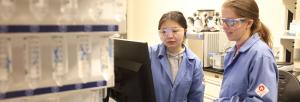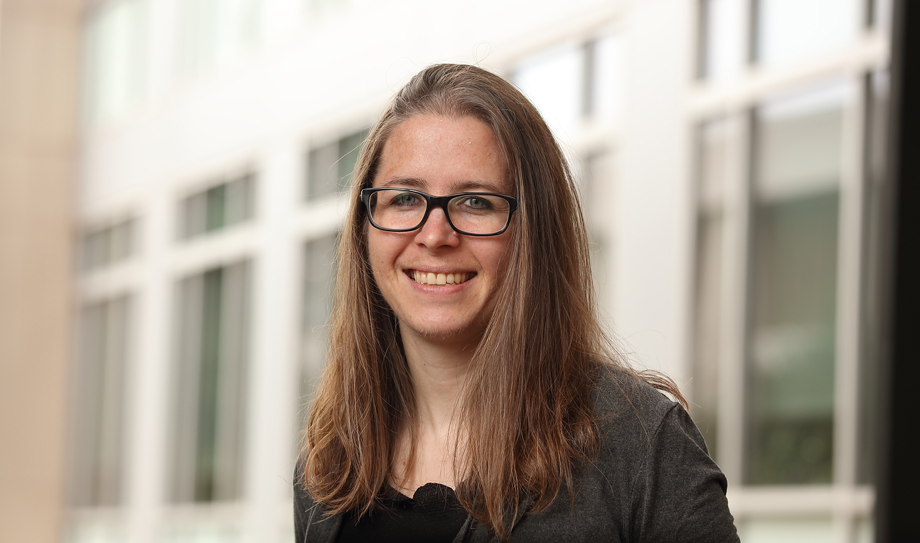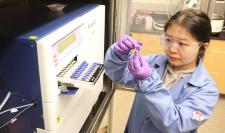
“Sorry I’m late,” Rachel Letteri said tuning into a Zoom call — hair still damp from a shower — to talk about an exciting new research grant from the National Institutes of Health.
“Someone in my running group dropped their keys, and we were retracing our steps to find them,” she said, before turning to how the NIH grant could help unlock the medicinal potential of peptides — protein fragments made of amino acids, which the body can use to fight everything from infection to stroke.
Letteri, an assistant professor in the University of Virginia Department of Chemical Engineering, runs regularly with colleagues, who include graduate students and faculty from UVA’s schools of Engineering and Applied Science and Medicine.
Those runs have led to ideas Letteri will explore through the grant, but the story also illustrates something crucial to her successful application for the NIH’s prestigious Maximizing Investigators’ Research Award for Early-Stage Investigators: The support and collegiality of the UVA research community.
The MIRA, as the grant is known, comes on the heels of another rising-star recognition for Letteri, the National Science Foundation CAREER Award. The MIRA is coveted because of its flexibility; the grant allows investigators to broaden their research scope within the mission of the National Institute of General Medical Sciences, without tying the research paths to a specifically funded project.

Assistant professor Steven Caliari earned a MIRA in 2020, and his reviews of Letteri’s proposal were critical.
“Steven had such an important role in this, from encouraging me to apply to reviewing application drafts,” Letteri said. “So many others contributed as well — the chemical engineering department is really incredible. And the polymer research community is also amazing, willing to provide input and support my students. It definitely was not a one-person effort by any stretch of the imagination.”
Letteri’s polymer biomaterials lab will receive $1.8 million over the next five years, which includes financial support for graduate students.
“One of the most exciting things about this MIRA is I started with probably the best — not probably, I started with the best students I could have asked for — to build the lab,” said Letteri, who arrived at UVA in 2018. “The flexible funding gives all of these really awesome students an opportunity to explore and build a new, central direction in the lab.”
All true, but Letteri is too modest, said William Epling, chair of the department.
“Rachel is so curious and creative in her approach, the MIRA is perfect for her,” said Epling, the Alice M. and Guy A. Wilson Professor of Chemical Engineering. “Biomaterials and tissue engineering have emerged as research areas where UVA is having an impact, and Rachel is a big part of that. There’s a lot of energy and excitement underlying their important work. For our department to get two MIRA awards in two years tells me others see that too.”
Letteri’s team members on the MIRA — Ph.D. students Mara Kuenen, Zixian Cui, Mark Bannon and Vince Gray — will focus on how to use the powerful chemistry of polymers to overcome the limitations of peptides as treatments in health care. Her lab specializes in biomaterials combining peptides with polymers to endow materials with new functions useful in engineering and medicine.
Polymers, sometimes called macromolecules, are any material composed of large molecules that are themselves made of repeating subunits, like building blocks. Those blocks and the chemical bonds between them can be altered in tiny ways that result in big changes to the material’s physical properties, such as whether it’s hard or soft, elastic or liquid, and how quickly it dissolves.
The design possibilities are endless, which is why both natural and manmade polymers are everywhere. They’re in food, clothing, plastics — and the clear, water-absorbing gels Letteri engineers in her lab to mimic living tissue. With the MIRA, she will also develop new therapeutic formulations.
The specific application of polymers to peptide therapeutics wasn’t in Letteri’s plans until she met Dr. Molly Hughes, a professor at the medical school’s Division of Infectious Diseases and International Health.
Hughes’ team was investigating immune-system peptides as new antibiotics against numerous multi-drug-resistant bacteria. They were looking for a collaborator familiar with peptide chemistry.
“I was ecstatic to receive a note from Professor Shayn Peirce-Cottler in biomedical engineering connecting me with Molly and her lab in my first couple weeks at UVA. The potential to advance medicine is why I got into research to begin with, and the opportunity to work in step with a clinician was incredibly exciting,” Letteri said, noting how important it is for engineers and researchers to calibrate their work to real-world needs that medical practitioners are exposed to every day.
Despite promising lab studies, few peptide therapeutics have made it past clinical tests because of various limitations.
“Peptides can be quite powerful as therapeutics for a range of conditions,” Letteri said. “The problem is they don’t last long in the bloodstream because they’re so small, or they’re cleared by the immune system. They can also be toxic to healthy cells, or may not be completely soluble.”
Enter the polymers.
“The goal of the MIRA project is to use polymers to present these therapeutic peptides in ways that help to maximize how they work,” Letteri said. “We need to pin down what molecular-level details really make these peptides shine as therapeutics.”
Potential presentations include attaching multiple peptides to a single polymer chain so they can work together or by encapsulating peptides within a polymer carrier to slowly make them available.


